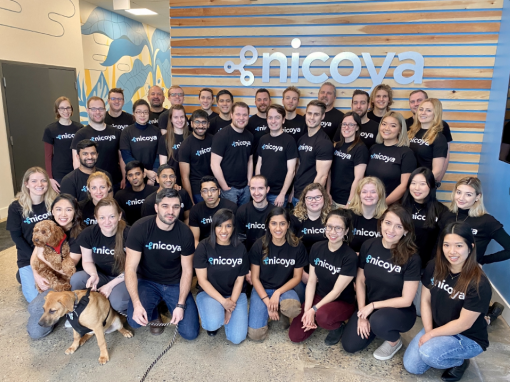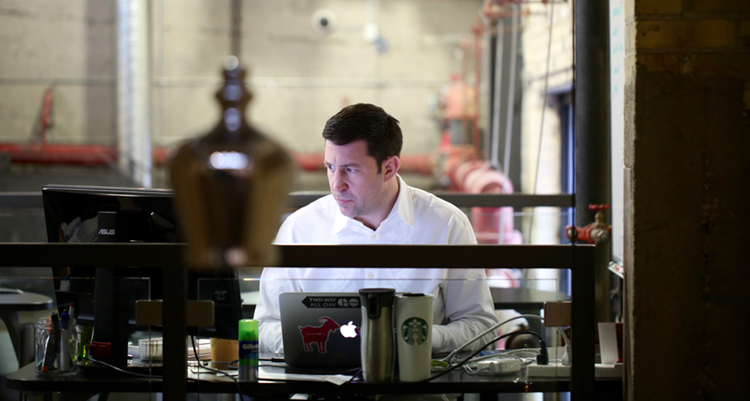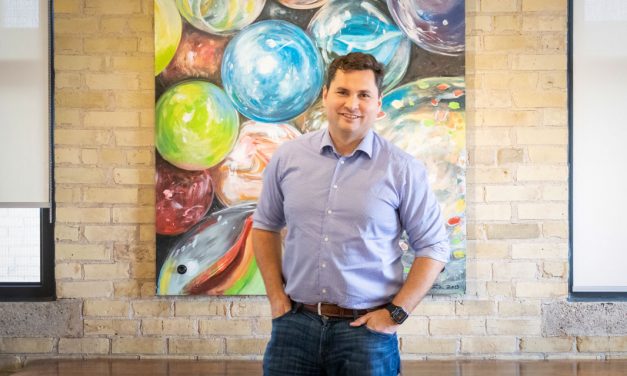It’s an anniversary you’d rather not celebrate but can’t ignore.
As the calendar tilts toward mid-March, a full year has passed since COVID-19 plunged Canada and the rest of the world into the harsh realities of a global pandemic.
The severity and scope of the crisis has been enormous. Yet the response and resilience has, in many ways, been just as remarkable.
It began in late December 2019 with reports of a growing cluster of pneumonia cases in Wuhan, China. A month later, the World Health Organization declared the coronavirus outbreak to be a Public Health Emergency of International Concern. Organizations around the world began planning for an extended remote-work scenario. By Friday, March 13, most Canadian employers had hit the launch button and millions of people across the country began working from home the following Monday.
As the world takes stock of the past 12 months, Communitech News checked in with members of the Waterloo Region tech community to find out how the pandemic has affected their companies.
“The breadth and depth of the challenges have been extraordinary,” says Communitech CEO Iain Klugman, who recently took on the added role of Strategic Advisor to Health Canada to support COVID-19 testing in private and public workplaces. “But tech companies in Waterloo Region have always been resilient and innovative. It’s impressive to see how well they’ve adapted, and how they’ve pulled together for one another and for the entire community.”
A lack of personal protective equipment (PPE) for health-care workers was one of the first challenges faced by many communities last March. In Waterloo Region, a community PPE drive was initiated by BlackBerry co-founder Mike Lazaridis, Wealthy Barber author David Chilton, Catalyst Capital co-founder Amber French and physician Dr. Neil Naik, with help from Communitech. The campaign rounded up thousands of donated masks, surgical gloves, hospital gowns and related supplies.
That effort led French, who also serves as Communitech’s Director of Strategic Capital, to spearhead the creation of a buying collective, PPE Access Canada. It helps supply doctors offices, hospices, group homes, homeless shelters and the like with badly needed supplies. In an effort to support the Canadian PPE industry, French and Chilton later created Supply + Protect Inc., a not-for-profit online market featuring Canadian-made PPE.
Meanwhile, individual companies scrambled to set up remote-work environments and figure out how to carry on their businesses in a world of lockdowns, travel bans and stay-at-home restrictions.
According to a number of reports, the digital nature of tech-driven companies made it less difficult for them to pivot to remote work; many were also able to pivot their products and services to help non-tech clients adapt to the brave new world of work-from-home.
“Overall, the pandemic is expected to have a net positive impact on the Canadian tech industry’s global competitive position,” says a recent Technology Industry Outlook report issued by the Business Development Bank of Canada (BDC).
“The pandemic had a severe impact on the world economy and affected the landscape in which Canadian tech firms operate,” the report states. “Yet, among major industries, technology has shown the strongest performance over the past decade and was well positioned when the pandemic struck. Moreover, the new context led to a surge in demand for companies supporting remote work, health tech and online learning.”
General assessments like these hold true for many tech companies in Waterloo Region.
Companies whose products and services help clients do more online have continued to thrive during the pandemic – think of online learning management company D2L, e-commerce platform Shopify, restaurant website tool Sociavore, online wholesale platform Faire, and information-management powerhouse Open Text, among many others.
Waterloo Region’s growing cybersecurity sector has also fared well. Companies such as eSentire, Arctic Wolf Networks and Magnet Forensics were already serving a fast-growing market; the mass transition to remote work has only heightened the need for cybersecurity services and expertise.
A number of the region’s other sectors, such as medtech, robotics and AI, have also remained strong throughout the pandemic. And a few companies, such as respirator-maker O2 Canada, saw demand for their products soar.
But there have been challenges. Ramping up staff and production to supply new demand, pivoting to new applications, scaling technology, and dealing with regulatory roadblocks – the list of hurdles is long and different for each company.
A case in point is Waterloo edtech firm Inksmith. CEO and founder Jeremy Hedges made headlines last year for his lightning-quick pivot to making protective face shields, first as a donation to health-care providers and then as a revenue-generating enterprise. Hedges launched a second company, The Canadian Shield, to make PPE; he expanded his workforce from 10 to 330 at peak productio, moved to a 50,000-square-foot facility, and invested millions in automation and production equipment.
But as the initial frenzy for PPE settled down, Hedges had to adjust again. The Canadian Shield laid off staff and Hedges is using the lull to devote more time to longer-term strategies. This includes working with government and industry colleagues to address a long list of issues, including the need for Canadian PPE product standards, enhancing the country’s approach to intellectual property, and revisiting hospital purchasing contracts that hinder Canadian manufacturers from building a sustainable PPE industry.
John Baker, CEO and founder of D2L, says many of the current challenges affecting Canadian technology companies have been around for some time. As a member of the federal government’s Industry Strategy Council (ISC), Baker led the digital-and-data consultations for the group’s recent recommendations for a national pandemic recovery strategy.
“On the technology side, it’s a fairly well understood set of problems,” says Baker, rhyming off familiar issues such as the need to scale more Canadian companies into world-leading enterprises, attracting and retaining employee talent, increasing R&D funding and spending, and enhancing IP and capital strategies.
“One thing that stood out for me,” he says of the ISC consultations, “is that half the world economy in the next three to four years is going to pivot to digital or digitally transformed, so we need to very quickly create world-leading companies in every one of these sectors. Otherwise, we will simply be consuming what’s coming from other locations around the world. I’d much rather see us become a nation of producers and not just consumers.”
Given Waterloo Region’s established tech ecosystem, the accelerated transition to digital across all industries bodes well for the community.
“We’re probably better positioned today than we have been at any point in our history,” says Baker.
For a closer look at the pandemic’s impact on the region’s tech industry, Communitech News talked to leaders from a sampling of companies, large and small. Here’s what we learned.
Nicoya
Kitchener-based Nicoya has had quite the wild ride over the past year.
The medtech startup, which uses nanotechnology and AI to make analytical instruments for scientists and medical professionals, began 2020 with a CDN$10-million Series A raise.
Then came the pandemic.

The team at Nicoya had a wild ride over the past year.
(Photo courtesy Nicoya)
“When it became a reality that most of our customers would be shut down for an indeterminate amount of time, we had to throw out the original operating plan for the year and re-budget and re-plan everything,” says CEO and founder Ryan Denomme. “After a few months of uncertainty, we established a new plan and, with the help of various Canadian COVID-relief programs and some additional capital, have been able to persevere through a year of great uncertainty.”
The first few months of the pandemic were the most challenging.
“We were in the middle of executing a hardware-based product launch when COVID-19 became a pandemic,” recalls Denomme. “We have development partners and suppliers all over the world. This caused a myriad of complex challenges that we have had to overcome to keep commercialization on track.”
Critical components were trapped in customs offices for weeks at a time due to lockdowns, and the necessity for virtual rather than in-person collaboration with development partners slowed the process of solving technical issues, completing prototypes and fixing integration problems between hardware and software.
Having a committed team with plenty of startup experience helped.
“Going through the process of starting a company prepares you to deal with unexpected challenges on a daily basis,” says Denomme. “Although we have found ways to deal with all of these challenges, they have come with additional unexpected costs that we have had to manage, and we have had to be very strategic with the new product roll-out in order to give us enough bandwidth.”
Nicoya, a University of Waterloo spinoff that got its start in 2012 and took part in Communitech’s Rev sales accelerator in 2015, also relied on Communitech resources over the past year.
“Communitech has been an exceptionally valuable resource throughout this period,” he says. “From help with COVID policy/protocols, access to mentors for guidance and many other critical areas of need, they have been remarkable to work with.”
The pandemic also prompted Nicoya to prioritize some of the customer service projects that had been set aside earlier while the company focused on growth.
“(We wanted) to be ready to get our customers back on track the second their labs opened up again,” says Denomme. “It allowed us to take time and build or rebuild the structure and tools we need to support our customers, both external and internal to Nicoya. We learned that prioritizing these efforts, even while everyone is so busy with growth work, is essential to building and expanding the solid foundation that will allow us to achieve our mission.”
Despite the challenges, the company had numerous successes over the past year. Last June, the federal government announced that Nicoya would receive up to $299,190 from the National Research Council’s Industrial Research Assistance Program (IRAP) to develop a portable COVID-19 diagnostic test for use in hospitals and testing labs, as well as local clinics and long-term care homes.
“We’re now on pace to have our biggest year of revenue growth in Nicoya’s history,” says Denomme.
The company has increased its workforce by 50 per cent over the past year and now employs 80 full-time equivalents.
“Nicoya is growing faster than it ever has and we expect this to continue well into the future,” says Denomme.
Plasticity Labs
For Plasticity Labs, the pandemic dealt a fatal blow.
The data-driven workplace well-being company was launched in 2012 by Jim and Jennifer Moss, a married couple with a passion for helping people improve their health and happiness.
With a mission to give people “the tools to live a happier life starting in the workplace,” Plasticity developed survey and analytics technology to measure a range of metrics, including employee engagement, satisfaction, sense of community, workplace stress and more.

Jim Moss, CEO of Plasticity Labs, in a 2016 file photo.
(Communitech photo: Anthony Reinhart)
Despite public accolades, awards and a successful track record, Jim Moss says that after eight years Plasticity Labs was still operating “paycheque to paycheque.”
The company shut its doors temporarily when the pandemic hit last March. A month later, the couple decided it was time to close the business down and move on.
“We were always kind of valued for being scrappy,” says Jim Moss. “But the company probably should have died a few times along the way, so it was almost too resilient… the fact that it went as long as it did is probably a bit of a miracle.
“Part of me felt like I was letting people down but I couldn’t have changed what was going to happen or needed to happen.”
Moss, a former multisport athlete who played professional lacrosse and professional hockey, had felt tremendous stress trying to keep the company going while raising a young family and dealing with a chronic autoimmune condition that periodically affects his walking and the use of his hands.
“It hurt like hell (to close the company) but then I started getting healthier quickly, which was strange because, in the middle of the pandemic, I was actually getting healthier right after we closed the company.”
Moss is now applying his expertise as the leader of a new workplace well-being service offered by the YMCAs of Cambridge and Kitchener-Waterloo. Jennifer Moss, who had stepped away from her day-to-day role at Plasticity prior to last March, continues to excel as a speaker, author and journalist. Her second book, The Burnout Epidemic, will be published by Harvard Business Review in September.
Jim Moss believes strongly in the value of self-reflection and self-awareness.
“I have no problem with being humble about the mistakes I made along the way,” he says.
In that spirit, he shared a few key learnings from his experience with Plasticity Labs:
- Growth, capital and mission. Moss says there was a “tension” between his desire to help people at the community level and the pressure to grow the business into something much larger. In particular, seeking outside capital required him to adapt his personal preferences to the expectations of investors and partners to expand the company across Canada. “If I could go back and do it differently, I would have bootstrapped longer and figured out a business model that was a bit more sustainable so you felt you had more control and could take the company in the direction you wanted, rather than maybe feeling pressure to take it a certain way.”
- Sustainability and resiliency. Building up organizational resiliency is essential, says Moss. That means growing your business to the point where it generates enough profit to create the cash reserves needed to get you through the tough times. “People don't realize how tenuous any company is, but until it's very safe, it's very tenuous,” he says. “You can’t ignore the reality that you need a rainy day fund, that you need something there to get you through those patches where the roof needs fixing or business dries up for whatever reason.”
- Speed of innovation. Plasticity Labs developed its own digital dashboard and interface to help employers track a variety of metrics related to employee engagement and well-being. But keeping its technology on the leading edge was a constant challenge. “If I could go back and do it differently, I would have done it as an invisible interface where we weren’t an interface in ourselves but we were delivered across other people’s interfaces. So, it would be, How could you bake it into Microsoft Office and Teams, how would you bake it into other technologies that people are using all the time… because building a new behaviour is really hard but borrowing a behaviour is a lot cheaper and a lot easier.”
- Don’t bet it all on one play. Moss and his team tried to address the interface challenge. They were close to a deal that would have allowed their platform to work through a well-established interface product, but the deal fell apart for an unanticipated reason. “We got really close to a partnership with a major interface but then the company was sold,” he says. “That was just kind of catastrophic because we had over-planned on that coming through. It was a bit of a rookie move.”
- Married co-founders. Moss was surprised to learn that investors are reluctant to fund a venture run by married co-founders. But he came to learn that running a business with your life-partner means that you rarely get a break from the stresses of work. “A family is your refuge, your haven,” he says. “When you're both working in the same company, the valleys are aligned and the peaks are aligned and you’re rarely able to support each other as well…. I think we would have done it a bit differently – one of us would have stayed working in something else and being supportive to the process but not being embedded in it.”
- Separate your identity from your business. Moss recommends that entrepreneurs “disentangle” their self-image and personal mission from that of the business. This pays off when you sell your company or have to wind it down. “People need to distinguish themselves from their work: What's your mission as an individual and what was the company's mission? To think, Oh yeah, I can keep going and doing work like this that I care about – it didn’t die when the company did, my personal mission and purpose in life can carry on.”
- The taboo of closing a business. While it’s trendy to talk about the lessons learned through failing, Moss says entrepreneurs by their very nature don’t like to give up on things, especially their companies. He says the business community needs to talk more about the emotional and practical aspects of shutting down a company so that entrepreneurs can stay healthy and move on. “People don't talk about closing down companies,” he says. “Obviously we’re not setting out to fail but we learn whatever is available to learn and if it’s closing down your business, take the opportunity to learn as much as you can about business through that process.”
- Self-reflection, self-awareness and innovation. Moss says it is essential for entrepreneurs and leaders to regularly reflect on what they’re doing and how they’re doing it. Self-reflection fuels innovation, motivation and the alignment between what you say and what you do. “Self-awareness and self-reflection are two of the things that I’m talking about with every leadership team right now (in his role at the YMCA), and the willingness to be humble as a result of those self-reflections of that self-awareness.”
Auvik Networks
Like many tech companies, Waterloo-based Auvik Networks has been working flat out since the start of the pandemic.
Launched in 2011, Auvik creates network-management software for IT managed-services providers – companies that manage a client business's technology and networks.
“Networks underpin our lives in countless ways, but the upheaval of COVID-19 upped the ante,” says Auvik CEO and co-founder Marc Morin. “Our customers scrambled to support new remote workforces amid increased network demands – all while adapting to the new processes and tools of remote work themselves. They relied on us to help them rise to the challenge, which we did, and we continue to do everything we can to support them.”

Marc Morin, CEO of Auvik Networks.
(Photo courtesy Auvik Networks)
Auvik paused its hiring early in the pandemic while it assessed what the COVID crisis might mean for its business. The company started hiring again later in the year and now has a staff count north of 160.
Early in the pandemic, Auvik was kept busy helping its clients help their clients adapt quickly to a remote-work environment.
“IT teams pulled off some heroic feats to set their users up for remote work in a matter of days,” says Morin. “Our customers transitioned to remote working and the various challenges that represented, from operational issues such as bandwidth household usage, to security, with users connecting from home networks that IT pros couldn’t control.”
“We spent the bulk of the second quarter helping our customers support their network users while they transitioned to remote working, as we did the same,” he says. “Our team members put in a lot of time and effort to help IT teams around the world rise to the challenge.”
Morin says the pandemic has been a real test of Auvik’s ability to respond quickly to customer needs while adapting to the challenges of remote work themselves.
“I’m proud of how our team learned to pivot effectively and efficiently – we’ve proven to be extremely resilient during a difficult time. With COVID-19 continuing to affect both people and businesses, we’ve strived to continue delivering our main objective – ensuring our customers have absolute confidence in their network management needs.”
Looking ahead, Morin says Auvik is exploring ways to “transition to the new norm” and enhance the ability to monitor and troubleshoot challenges that the end-user is experiencing.
“Our service currently offers deep, real-time visibility into network infrastructure. As the world shifts to a new way of work, with more applications and a remote workforce, a new set of problems has emerged,” he says. “The issue is the visibility gap, with IT pros not knowing what’s happening at the home network. We’re interested in broadening the opportunity for network management and we talk about ‘glass to SaaS’ at Auvik, to give our customers the visibility to make sure their teams are productive.”
Wavy
For a startup that helped people explore in-person activities in their communities, the pandemic had the potential to be a real buzz kill.
But the three co-founders of Wavy pivoted quickly and began offering fun, shared experiences online to bring work teams and other groups together.
From wine-tasting to cooking, yoga, photography, trivia, gaming and more, Wavy draws on a roster of partners across Canada to create and facilitate shared virtual activities.

Wavy CEO Shawn Hewat (third from left, striped shirt) with members of her team.
(Photo courtesy Wavy)
“We launched in 2018,” says co-founder and CEO Shawn Hewat. “Fast forward to March (2020) and it doesn't make a lot of sense to tell people to go out and explore their city anymore. So we got to talking with our community and we just started hearing over and over again that just because people are physically distant doesn't mean they still don’t want to have shared experiences.”
Wavy’s three co-founders – Hewat, Neshay Ahmed and Peter Kotzeff – had each worked in the tech space. Hewat and Neshay also had experience in employee engagement.
The trio began brainstorming possible virtual experiences and building up their network of sommeliers, chefs, fitness instructors, artists, photographers, game designers and others to help deliver the activities.
“Our goal is to create something that feels as far away from a webinar as possible,” says Hewat.
With that in mind, Wavy works with clients to customize experiences, build conversation and break-out activities into its events, and provide participants with materials and ingredients they need for things like wine-tasting, beer-tasting and cooking.
Wavy began its online offerings last spring, starting with an ambitious three-day virtual arts and culture event called Stayhome Fest. The lineup included music, trivia games, “campfire” singalongs, and sessions on meditation, fitness, art, cooking and more. Wavy donated $5 from each ticket sale to the COVID-19 Mental Health Resiliency and Coping Fund run by the Centre for Addiction and Mental Health.
The pivot to virtual experiences has kept Wavy busy. The startup, which launched with family and angel investment in 2018, has been able to bootstrap since then, says Hewat. The company has grown from three co-founders to a team of eight. Employees work remotely, with half in Toronto and half in British Columbia, says Hewat.
Wavy has several connections to Waterloo Region. Co-founder and CTO Neshay Ahmed graduated with a degree in computer science from the University of Waterloo. The company also participated in Communitech’s Fierce Founders Bootcamp for women entrepreneurs in 2019 and was one of two runners-up in the pitch competition that year.
Looking forward, Hewat says the pandemic has accelerated the need for effective virtual engagement among work teams and other groups. Wavy is looking at related market opportunities such as providing fulfilment services, do-it-yourself and asynchronous activity models, workplace well-being, and employee perks and recognition opportunities.
“It's turned out to be something that will grow bigger than our initial idea,” she says. “Over 82 per cent of companies are planning to be remote or hybrid for the long term, so there's going to be this ever-growing problem of how these teams can build company culture in a way that’s just as good or better than in person.”
D2L
John Baker and his team at D2L began monitoring the COVID-19 reports in early January 2020. As a global provider of online learning management systems, the first warning signs came from the company’s international clients.
“We had an early indication when we had a number of clients in Australia start to request to have all of their courses pivoted online overnight in January,” says Baker, D2L’s CEO and founder.
“So, early in the pandemic we made a prediction about the impact in North America and we quickly pivoted to help a lot of clients move to fully online overnight.”

John Baker, CEO of D2L, in the company’s global headquarters in Kitchener.
(Communitech photo: Anthony Reinhart)
One of the first things D2L did was ensure that its employees were prepared and equipped to work in a safe, remote environment.
“We were very early to pivot to work from home and we were very quick to make sure our people were OK,” says Baker. “Then we turned our attention to clients, making sure everything is going to run smoothly.”
The first weeks and months were frenetic as D2L worked around the clock to help their clients – schools, universities and companies – put more courses online, adapt to a surge in users, and maintain their systems’ “uptimes.”
“We really had two key rules, other than making sure our people were looked after. First, keep our clients up – we want to be highly reliable, we don’t want them (clients) to have any stress about D2L. And two, keep them happy. If we could help as a partner with them going through this transition, then that was paramount. And we achieved both.”
One of the biggest challenges for D2L was keeping up with demand. The company, which Baker launched in 1999 as a co-op student in systems design engineering at the University of Waterloo, hired 333 staff since the start of the pandemic, bringing their total workforce to more than 900 worldwide.
In addition to bringing new clients on board and helping existing clients upload more courses and add more users, the D2L teams continued to enhance existing features and build new ones to “help our clients make the leap to the new reality.”
“A good example,” says Baker, “is a portfolio product that was used heavily in classrooms to allow students to capture the learning experiences and give parents a window into the classroom. Early in the pandemic, we pivoted that so that it would go the other way, where students could capture the learning that’s happening at home and give the teachers a window into the home learning.”
Baker says the pandemic has been a “catalyst” that’s pushed the adoption of technologies like online learning systems far ahead of earlier forecasts. One study that D2L was involved with prior to the pandemic showed that 86 per cent of all corporate training was still being done in classrooms.
“This has changed overnight,” he says, adding that adoption rates of online learning technology are several years ahead of pre-pandemic forecasts. “And we anticipate that that will continue to be a trend as we go forward.”
Looking back over the past year, Baker says he is impressed with and grateful for his team’s efforts and accomplishments.
“I’m really proud of what we did in terms of helping millions of people get online literally overnight. We kept their uptime at better than 99.99 per cent so people didn’t have any problems shifting to online using our technology.”

